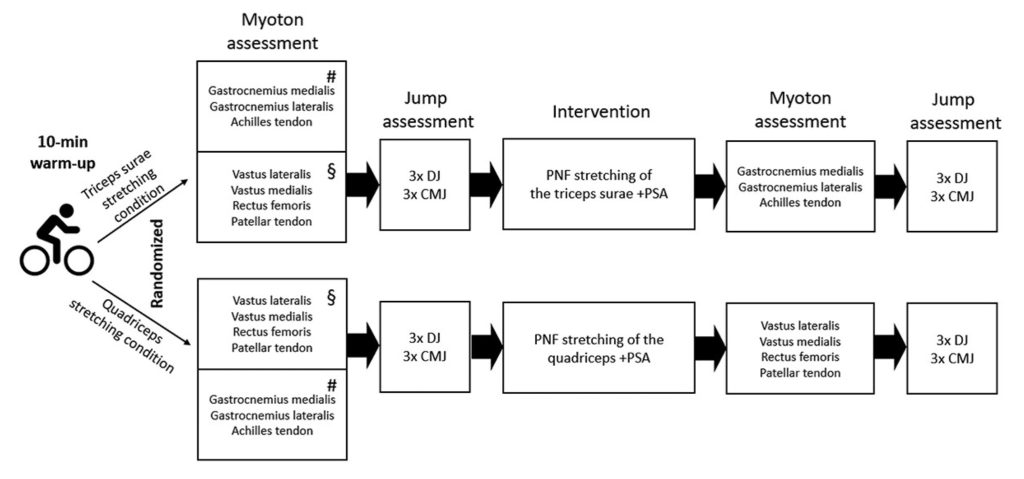Publications

What to stretch? – Isolated proprioceptive neuromuscular facilitation stretching of either quadriceps or triceps surae followed by post-stretching activities alters tissue stiffness and jump performance
Authors: Andreas Konrad 1, 2, Wolfgang Seiberl 3, Markus Tilp 1, Denis Holzer 2, Florian Kurt Paternoster 2
Affiliations:
- Institute of Human Movement Science, Sport and Health, Graz University, Graz, Austria
- Biomechanics in Sports, Technical University of Munich, Munich, Germany
- Institute of Sport Science, Department of Human Sciences, University of the Bundeswehr Munich, Munich, Germany
Journal: Sports Biomechanics - April 2022 (DOI: 10.1080/14763141.2022.2058991)
-
Field & Applications:
- Sport
- Warm-up / Recovery
- Muscle development / Performance
- Reliability
To overcome a possible drop in performance following longer stretch durations (>60 s), post-stretching dynamic activities (PSA) can be applied. However, it is not clear if this is true for isolated proprioceptive neuromuscular facilitation (PNF) stretching of different muscle groups (e.g., triceps surae and quadriceps).
Thus, 16 participants performed both interventions (triceps surae PNF + PSA; quadriceps PNF + PSA) in random order, separated by 48 h. Jump performance was assessed with a force plate, and tissue stiffness was assessed with a MyotonPRO device.
While no changes were detected in the countermovement jump performance, the PNF + PSA interventions resulted in a decrease in drop jump performance which led to a large magnitude of change following the triceps surae PNF + PSA and a small-to-medium magnitude of change following the quadriceps PNF + PSA. Moreover, in the triceps surae PNF + PSA intervention, a decrease in Achilles tendon stiffness was seen, while in the quadriceps PNF + PSA intervention, a decrease in the overall quadriceps muscle stiffness was seen.
According to our results, we recommend that especially triceps surae stretching is avoided during warm-up (also when PSA is included) when the goal is to optimise explosive or reactive muscle contractions.

Figure 1. Schematic schedule of the study; CMJ = countermovement jump; DJ = drop jump; PNF = proprioceptive neuromuscular facilitation; PSA = post-stretching dynamic activities; # = indicates the reliability check of the stiffness assessment of the triceps surae; § = indicates the reliability check of the stiffness assessment of the quadriceps.
Keywords: stretching, proprioceptive neuromuscular facilitation, contract-relax, intermuscular responses
This is the first study to have compared the acute effects of isolated stretching of two major lower leg muscles (i.e., triceps surae and quadriceps) with PSA to have detected possible respective responses to stretching exercises. The results showed that PNF stretching + PSA has the potential of deteriorating performance of movements involving explosive or reactive muscle contractions (i.e., a DJ), due to the possible influence on muscle–tendon interaction. The negative effects in DJ height and DJ RSI showed a large effect size following PNF stretching + PSA of the triceps and a medium effect size following PNF stretching + PSA of the quadriceps. However, these negative effects observed in DJ do not seem to play a comparable role in movements with slower stretch-shortening cycles (i.e., a CMJ).


